AUDI Q5 2017 Owners Manual
Manufacturer: AUDI, Model Year: 2017, Model line: Q5, Model: AUDI Q5 2017Pages: 296, PDF Size: 74.43 MB
Page 261 of 296
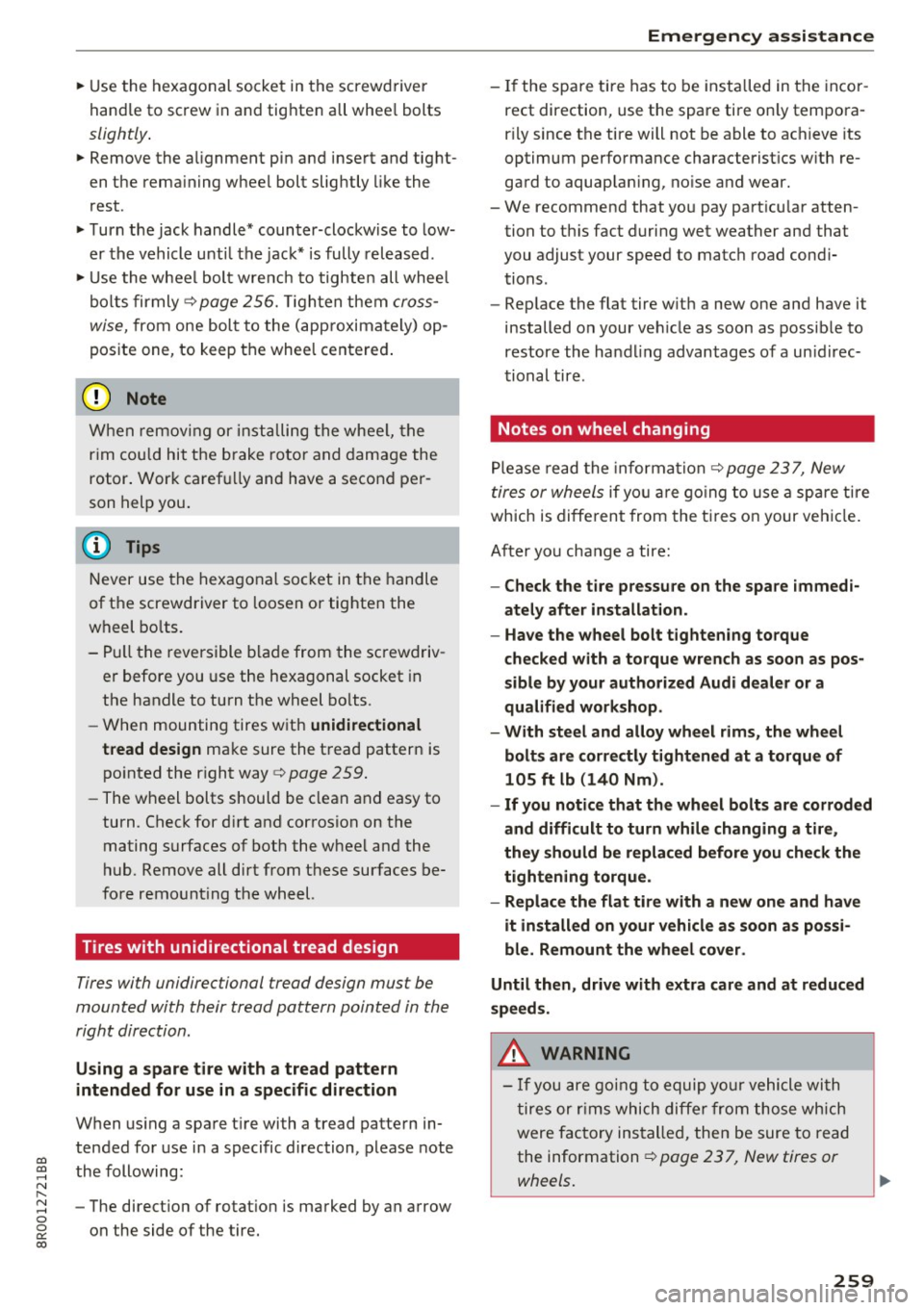
CD
CD
.... N ,-... N .... 0 0 C<'. 00
~ Use the hexagonal socket in the screwdriver
handle to screw in and tighten all whee l bolts
slightly .
~ Remove the alignment pin and insert and tight
en the remaining wheel bolt slightly like the
rest .
~ Turn the jack handle* counter-clockwise to low
er the vehicle until the jack* is fully released .
~ Use the wheel bolt wrench to tighten all wheel
bolts firmly
Q page 256. Tighten them cross
wise,
from one bolt to the (approximately) op
posite one, to keep the wheel centered .
Q) Note
When removing or installing the whee l, the
rim could hit the brake rotor and damage the
rotor. Work carefu lly and have a second per
son help you.
(D Tips
Never use the hexagonal socket in the handle
of the screwdriver to loosen or tighten the
wheel bolts.
- Pull the reversible blade from the screwdriv
er before you use the hexagonal socket in
the handle to turn the wheel bolts.
- When mounting tires w ith
unidirectional
tread design
make sure the tread pattern is
pointed the right way
Q page 259.
- The wheel bolts should be clean and easy to
turn. Check for d irt and corrosion on the
mating surfaces of both the wheel and the
hub. Remove all dirt from these surfaces be
fore remount ing the wheel.
Tires with unidirectional tread design
Tires with unidirectional tread design must be
mounted with their tread pattern pointed in the
right direction .
Using a spare tire with a tread pattern
intended for use in a specific direction
When using a spare t ire with a tread pattern in
tended for use in a specific direction, please note
the following:
- The direct ion of rotat ion is marked by an arrow
on the side of the tire.
Emergency assistance
- If the spare tire has to be installed in the incor
rect direction, use the spare tire on ly tempora
r il y since the tire will not be able to ac hieve its
optimum performance characterist ics with re
gard to aquap lan ing, no ise and wear.
- We recommend that you pay part icu lar atten
tion to th is fact during wet weather and that
you adjust your speed to match road cond i
tions.
- Rep lace the flat tire w ith a new one and have it
installed on your veh icle as soon as possible to
restore the handling advantages of a un id irec
tional tire .
Notes on wheel changing
Please read the information Qpage 237, New
tires or wheels
if you are going to use a spare tire
which is different from the tir es on your veh icle.
After you change a tire:
- Check the tire pressure on the spare immedi
ately after installation.
- Have the wheel bolt tightening torque
checked with a torque wrench as soon as pos
sible by your authorized Audi dealer or a
qualified workshop.
- With steel and alloy wheel rims, the wheel
bolts are correctly tightened at a torque of
105
ft lb (140 Nm).
- If you notice that the wheel bolts are corroded
and difficult to turn while changing a tire,
they should be replaced before you check the
tightening torque.
- Replace the flat tire with a new one and have
it installed on your vehicle as soon as possi
ble. Remount the wheel cover.
Until then, drive with extra care and at reduced
speeds.
.&_ WARNING
- If you are going to equip your vehicle with
tires or rims which differ from those which
were fac tory installed, then be sure to read
the information
Q page 237, New tires or
wheels .
-
259
Page 262 of 296
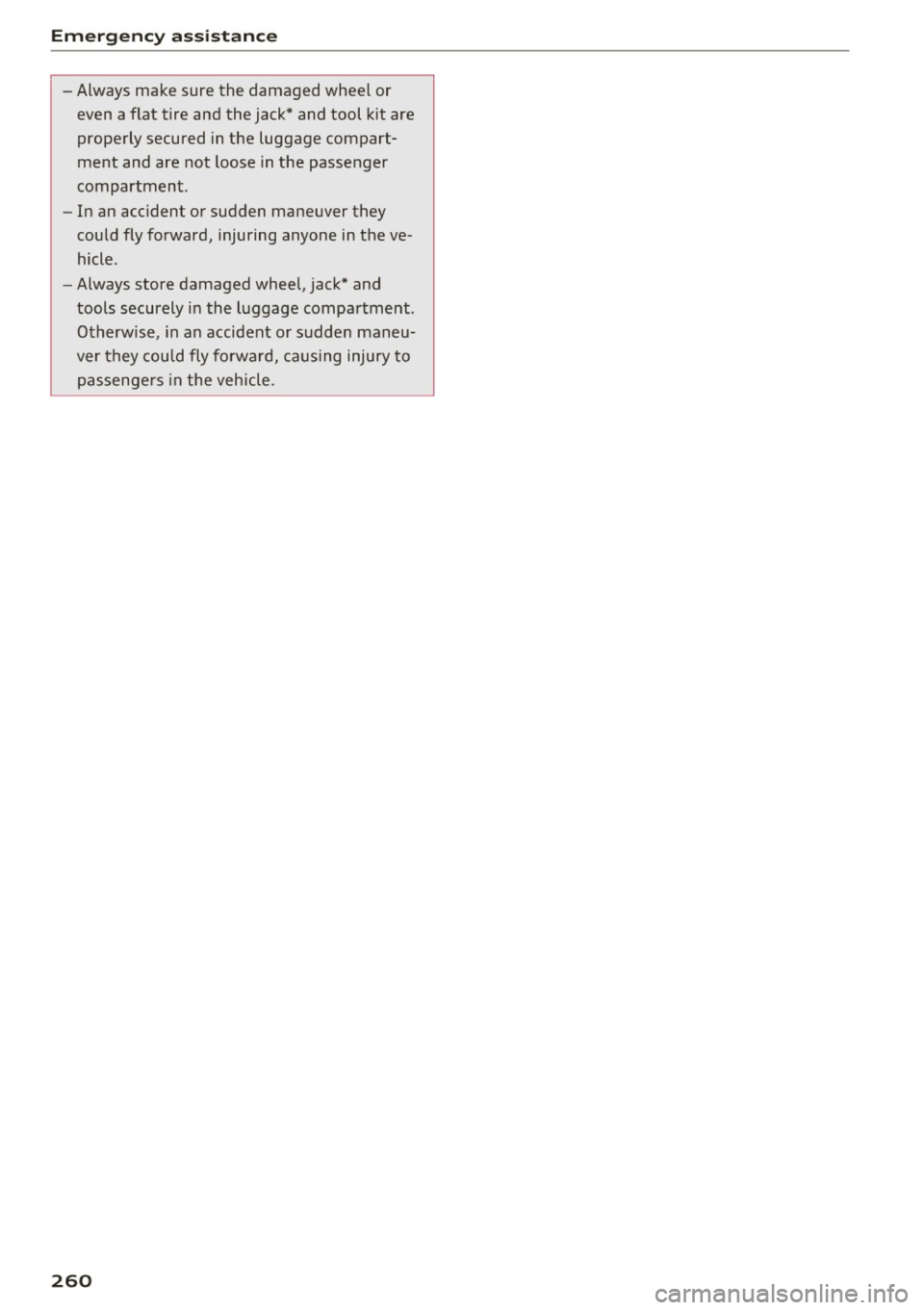
Emergency assistance
-Always make sure the damaged wheel or
even a flat tire and the jack* and tool kit are
properly secured in the luggage compart
ment and are not loose in the passenger
compartment.
- In an accident or sudden maneuver they
could fly forward, injuring anyone in the ve
hicle.
- Always store damaged wheel, jack* and
tools securely in the luggage compartment .
Otherwise, in an accident or sudden maneu
ver they could fly forward, causing injury to
passengers in the vehicle .
260
Page 263 of 296
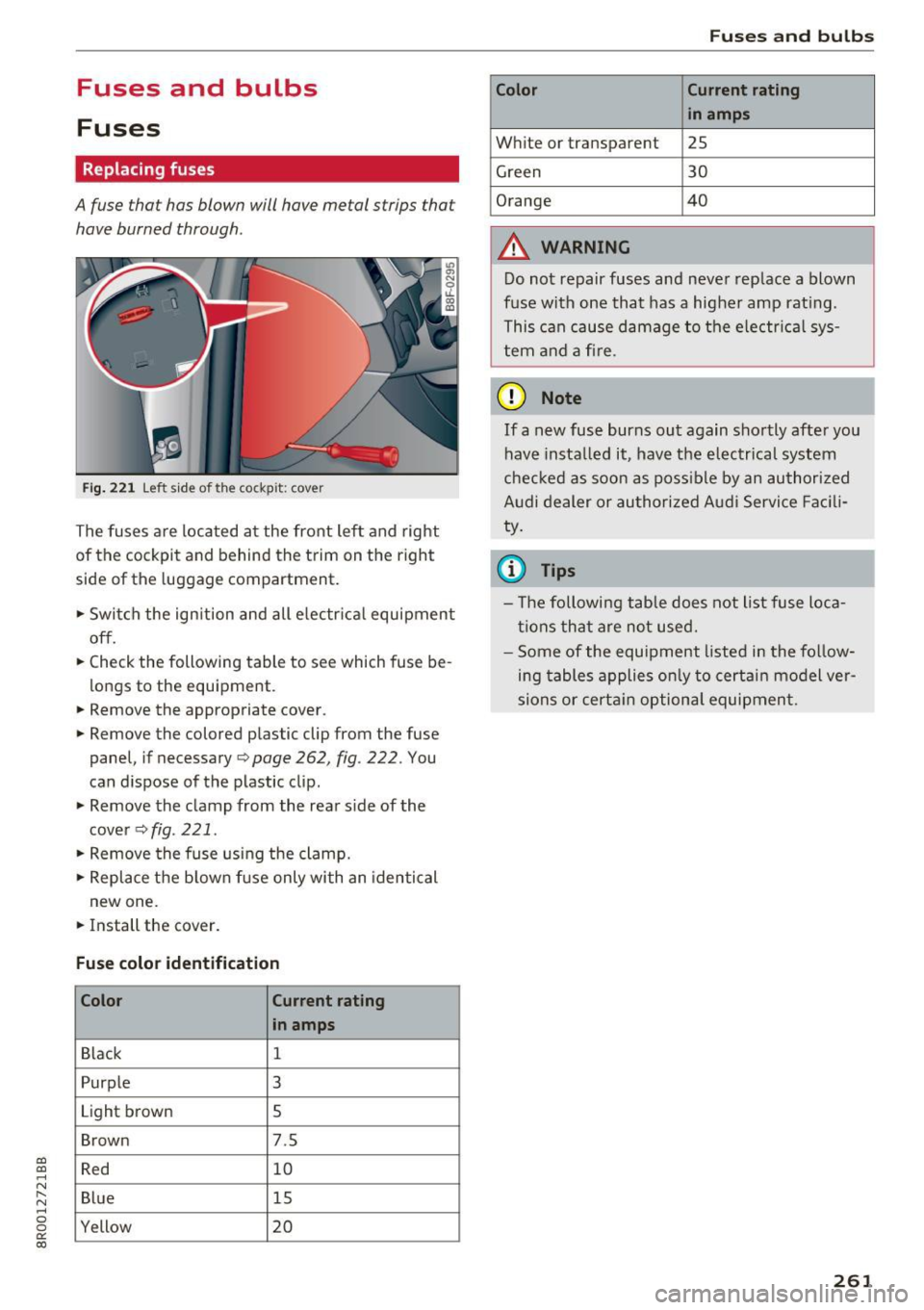
a,
a,
..... N r-N ..... 0 0
0:
co
Fuses and bulbs
Fuses
Replacing fuses
A fuse that has blown will have metal strips that
have burned through .
Fig. 221 Left side of the cockpit: cover
The fuses are located at the front left and right
of the cockpit and behind the trim on the right
side of the luggage compartment.
.,. Switch the ign ition and all e lectr ica l equipment
off.
.,. Check the following table to see which fuse be
longs to the equipment .
.,. Remove the appropriate cover .
.,. Remove the colored plastic clip from the fuse
panel, if necessary
c> page 262, fig. 222. You
can dispose of the plastic clip .
.,. Remove the clamp from the rear s ide of the
cover
c> fig . 221 .
.,. Remove the fuse using the clamp .
.,. Replace the b lown fuse only with an identical
new one .
.,. Install the cover.
Fuse colo r identification
Color Cur rent rating
in amp s
Black 1
Purple 3
Light brown 5
Brown 7.5
Red 10
Blue 15
Yellow 20
Fu ses a nd bulb s
C olor Current rating
in amps
White or transparent 25
Green 30
Orange 40
A WARNING
Do not repair fuses and never replace a blown
fuse with one that has a higher amp rat ing.
This can cause damage to the e lectr ica l sys
tem and a fire.
0 Note
If a new fuse burns out again shortly after you
have instal led it, have the electrical system
checked as soon as possible by an authorized
A udi dealer or authorized Audi Service Facili
ty.
(0 Tips
- T he following table does not list fuse loca
tions that are not used.
- Some of the equipment listed in the fo llow
ing tables applies on ly to certa in model ver
sions or certa in optional equipment .
261
Page 264 of 296

Fuses and bulbs
Left cockpit fuse assignment
Fig. 222 Left side of the cockp it: fuse panel with p lastic
clip
Fuse panel @ (black)
No . Equipment
1 Dynamic steering
2 ESC control module
A/C system pressure sensor, electrome-
3 chanical parking
brake, Homelink, auto-
matic dimming interior rearview mirror,
air quality/outside air sensor, ESC button
s Sound actuator/exhaust sound tuning
6 Headlight range control/corner ing light
7 Headlight (cornering light)
Control modules (electromechanical park-
8 ing brake, shock absorber, quattro Sport,
trailer hitch), DCDC converter
9
Adaptive cruise control or high voltage
battery (hybrid dr ive)
11 Side assist
12 Headlight range control, parking system
13 Airbag
14 Rear wiper
15 Auxiliary
fuse (instrument panel)
16 Auxiliary fuse te rm inal 15 (engine area)
262
Fuse panel ® (brown)
No. Equipment
1 Electric exhaust door
2 Brake
light sensor or brake pedal move-
ment sensor (hybrid drive)
3 Fuel pump
4 Ad
Blue pumps or brake booster power
supply (hybrid dr ive)
s
Left seat heating with/without seat venti-
lation
6 ESC
7 Horn
8
Left front doo r (window regulator, central
locking, mirror, switch, lighting)
9 Wiper motor
10 ESC
11 L
eft rear doo r (window regulator, switch,
li ght ing)
12 Rain and light sensor
Fuse panel
© (red)
No. Equipment
3 Lumbar support
4 Dynamic steering
5 Climatized cup holder
6 Windshie
ld washer system, headlamp
washer system
7 Vehicle electrical system control module 1
8 Vehicle electrical system control module 1
9 Panorama roof
10 Vehicle electrical system control module 1
11 Sun shade (panorama sunroof)
12 Anti-theft alarm system
Page 265 of 296
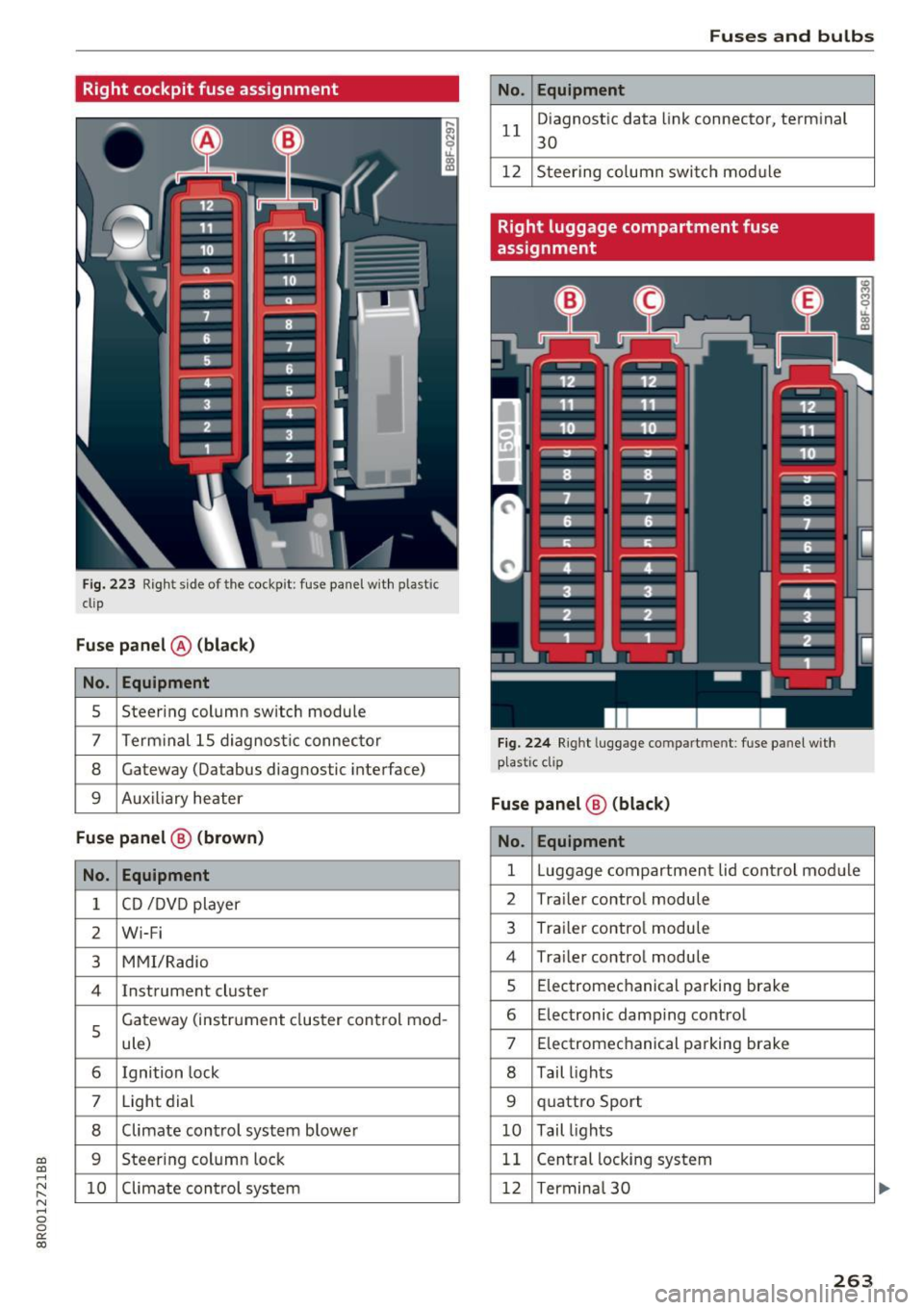
a,
a,
..... N r-N ..... 0 0
0:
co
Right cockpit fuse assignment
Fig. 223 Right side of the cockpit: fuse panel wit h plastic
clip
Fuse panel @ (black)
No . Equipment
5 Steering column switch module
7 Terminal 15 diagnostic connector
8 Gateway (Databus diagnostic interface)
9 Auxil iary heater
Fuse panel @ (brown)
No. Equipment
1 CD /DVD player
2 Wi-Fi
3 MMI/Radio
4 Instrument cluster
5
Gateway (instrument cluster control mod-
ule)
6 Ignition lock
7 Light dial
8 Climate control system blower
9 Steering column lock
1 0 Climate control system
Fuses and bulbs
No . Equipment
11 Diagnostic data
link connector, terminal
30
12 Steering column switch module
Right luggage compartment fuse
assignment
Fig. 224 Right luggage compartment: fuse panel with
pla stic dip
Fuse panel @ (black)
No. Equipment
1 Luggage compartment lid control module
2 Trailer control module
3 Traile r control module
4 Tra iler control module
5 Electromechanical parking brake
6 Electronic damping control
7 Electromechanical parking brake
8 Tail lights
9 quattro Sport
10 Tail lights
11 Central locking system
12 Termina l 30
263
Page 266 of 296
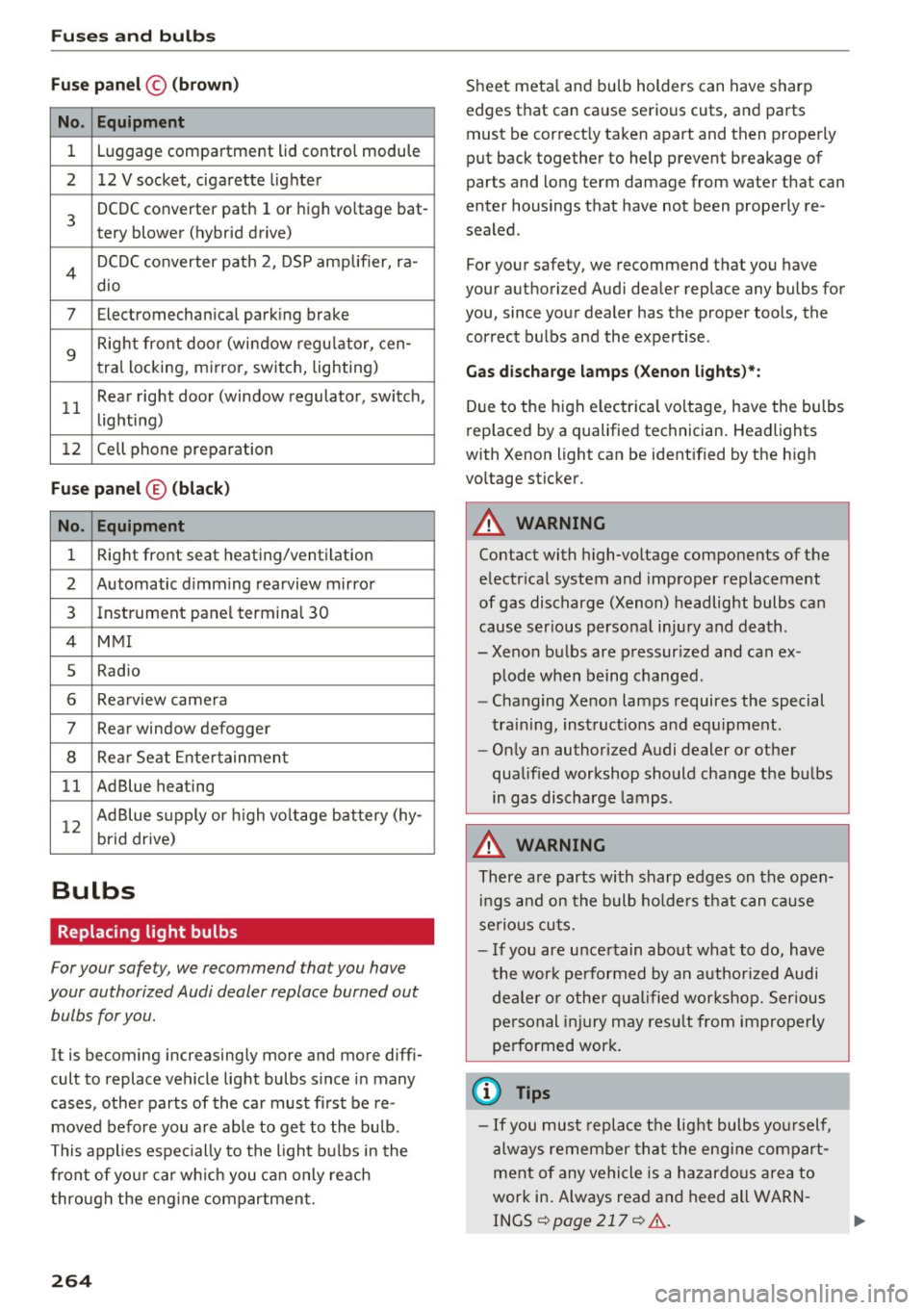
Fuses a nd bul bs
Fu se pa nel© (bro wn)
No. Equipment
1 Luggage compartment lid control module
2 12 V socket, cigarette lighter
3
DCDC converter path 1 or high vo ltage bat-
tery blower (hybrid drive)
4 DCDC converter path 2, DSP amp lifier, ra-
dio
7 Electromechanical
parking brake
9
Right front door (window regu lator, cen-
tral locking, mirror, switch, lighting)
11 Rear right
door (window regulator, switch,
lighting)
12 Cell phone preparation
F
use panel © (black )
No. Equipment
1 Rig ht
front seat heating/venti lation
2 Automatic dimming rearview mirror
3 Instrument
panel terminal 30
4 MMI
5 Radio
6 Rearview camera
7 Rear window defogger
8 Rear Seat Entertainment
11 AdBlue heating
12 Ad Blue supply or h
igh vo ltage battery (hy-
brid drive)
Bulbs
Replacing light bulbs
For your safety, we recommend that you have
your authorized Audi dealer replace burned out bulbs for you.
It is becoming increasingly more and more diffi
cult to replace vehicle light bulbs since in many
cases, other parts of the car must first be re
moved before you are able to get to the bu lb.
This applies espec ially to the light bulbs in the
front of your ca r wh ich you can only reach
through the eng ine compartment.
2 6 4
Sheet meta l and bu lb holders can have sharp
edges that can cause serious cuts, and parts
must be correctly taken apart and then properly
put back together to help prevent breakage of
parts and long term damage from water that can
enter housings that have not been properly re
sealed.
For your safety, we recommend that you have
your authorized Audi dealer replace any bulbs for
you, since your dealer has the proper tools, the correct bulbs and the expertise.
Ga s d ischar ge lam ps (Xeno n light s)*:
Due to the high e lectrica l voltage, have the bulbs
rep laced by a qualified technician. Headlights
with Xenon light can be identified by the h igh
voltage sticker.
A WARNING
-
Contact with high-voltage components of the
electr ical system and improper replacement
of gas discharge (Xenon) headlight bulbs can
cause ser ious persona l injury and death .
- Xenon bulbs are pressur ized and can ex
plode when being changed .
- Changing Xenon lamps requires the special
tra ining, instruct ions and equ ipment .
- Only an authorized Audi dealer or other
qualified workshop should change the bulbs
in gas discharge lamps .
A WARNING
There are parts with sharp edges on the open
ings and on the bulb ho lders that can cause
serious cuts.
- If you are uncertain about what to do, have
the wor k performed by an authorized Audi
dea ler or other qual ified workshop. Ser ious
personal injury may resu lt from improperly
performed work .
(D Tips
-If you must replace the light bulbs you rself,
always remember that the eng ine compart
ment of any vehicle is a hazardous area to
work in. Always read and heed all WARN
INGS
¢page 217 ¢ &.
Page 267 of 296
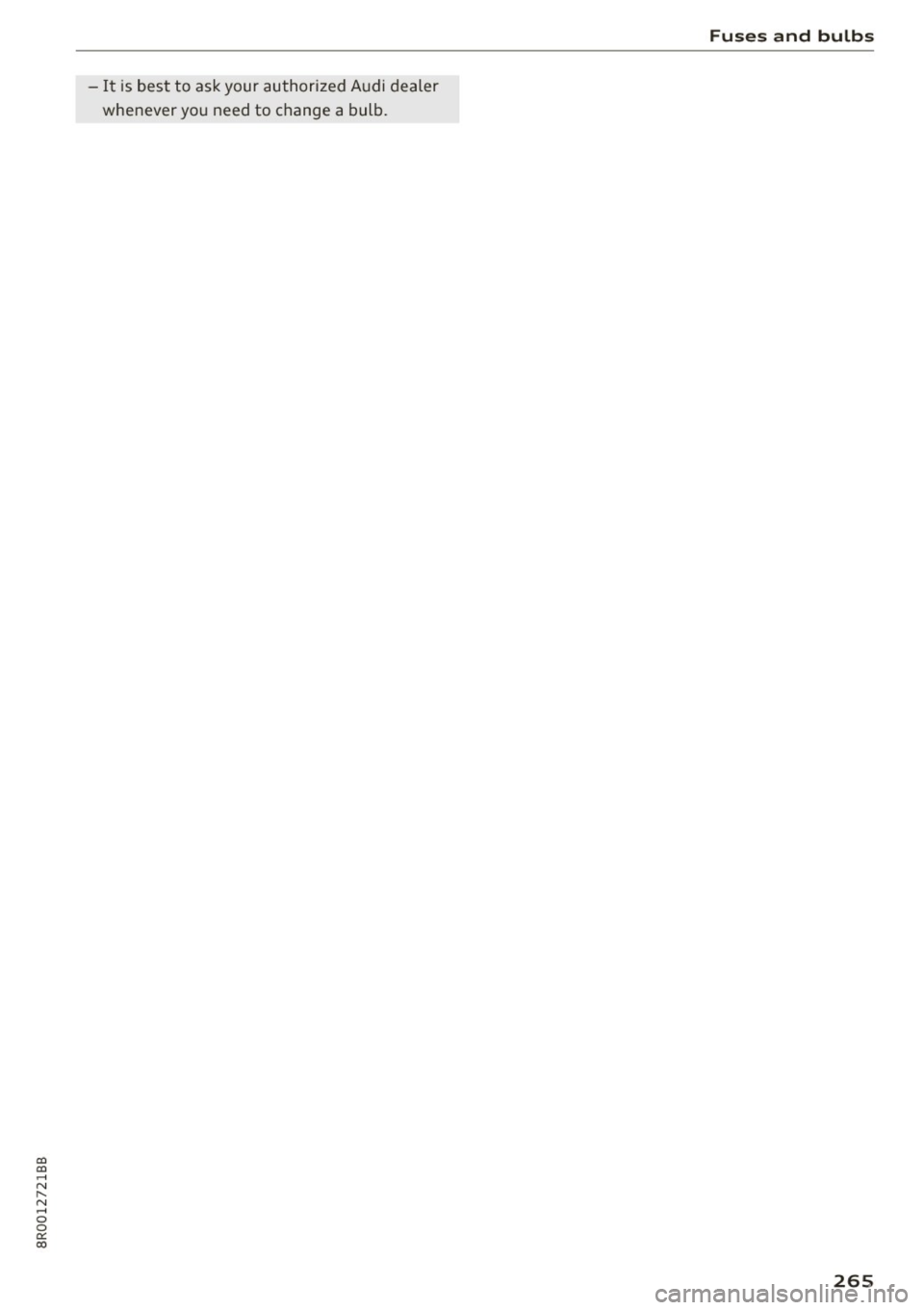
CD
CD
.... N ,-... N ..... 0 0 C<'. 00
-It i s best to ask your authorized A udi dealer
whenever you need to change a bulb.
Fuses and bulbs
265
Page 268 of 296
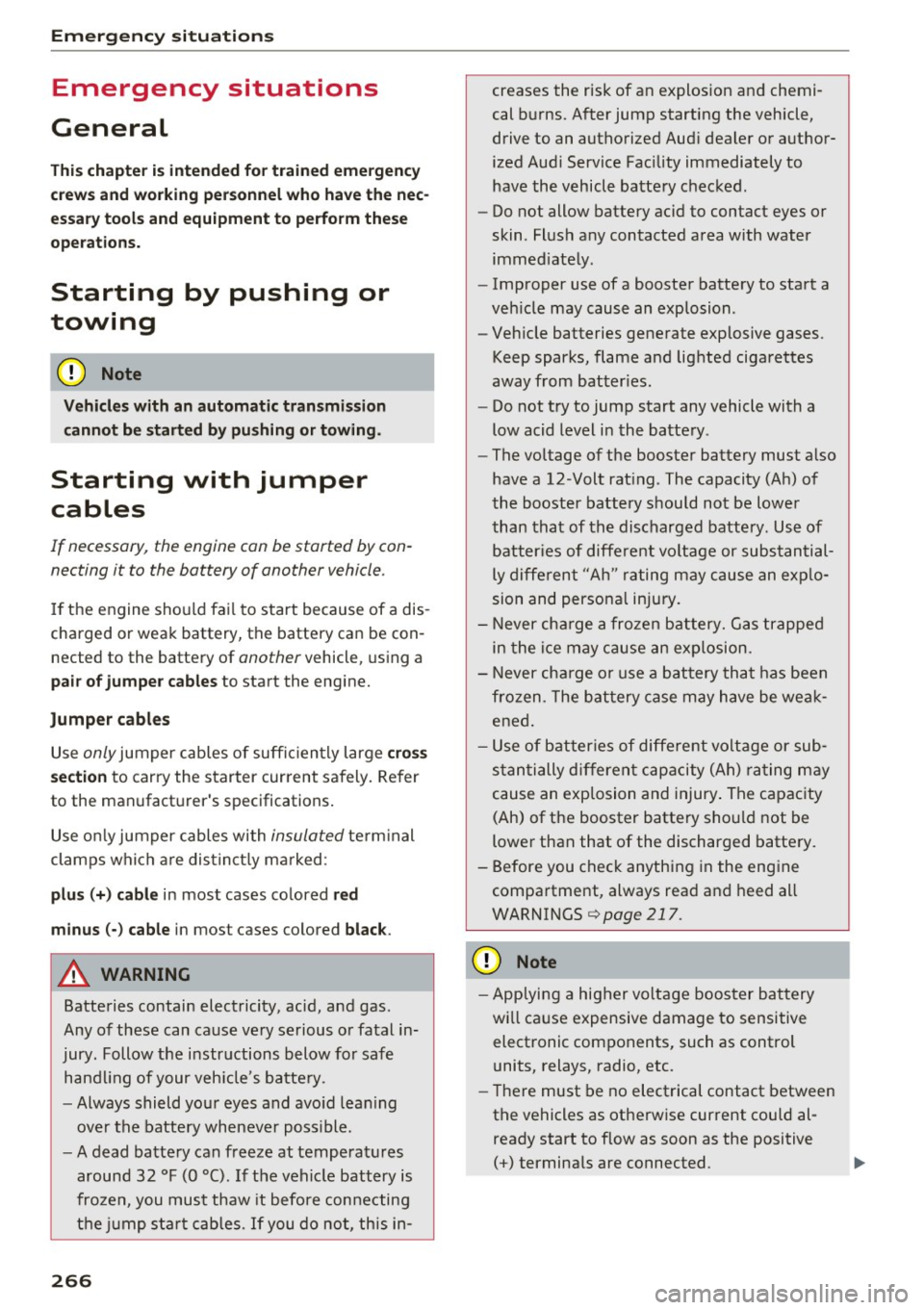
Emergency situations
Emergency situations
General
This chapter is intended for trained emergency crews and working personnel who have the nec
essary tools and equipment to perform these
operations.
Starting by pushing or
towing
(D Note
Vehicles with an automatic transmission
cannot be started by pushing or towing.
Starting with jumper
cables
If necessary, the engine con be started by con
necting it to the battery of another vehicle.
If the engine should fail to start because of a dis
charged or weak battery, the battery can be con
nected to the battery of
another vehicle, using a
pair of jumper cables to start the engine.
Jumper cables
Use only jumper cables of sufficiently large cross
section
to carry the starter current safely. Refer
to the manufacturer's specifications.
Use only jumper cables with
insulated terminal
clamps which are distinctly marked :
plus(+) cable in most cases colored red
minus(-) cable
in most cases colored black.
A WARNING
Batteries contain electricity, acid, and gas.
Any of these can cause very serious or fatal in
jury. Follow the instructions below for
safe
handling of your vehicle's battery.
-Always shield your eyes and avoid leaning
over the battery whenever possible.
-A dead battery can freeze at temperatures
around 32 °F (0 °C) . If the vehicle battery is
frozen, you must thaw it before connecting
the jump start cables.
If you do not, this in-
266
creases the risk of an explosion and chemi
cal burns. After jump starting the vehicle,
drive to an authorized Audi dealer or author
ized Audi Service Facility immediately to
have the vehicle battery checked.
- Do not allow battery acid to contact eyes or
skin . Flush any contacted area with water
immediately.
- Improper use of a booster battery to start a
vehicle may cause an explosion .
- Vehicle batteries generate explosive gases.
Keep sparks, flame and lighted cigarettes
away from batteries.
- Do not try to jump start any vehicle with a
low acid level in the battery.
- The voltage of the booster battery must also
have a 12-Volt rating. The capacity (Ah) of
the booster battery should not be lower
than that of the discharged battery. Use of
batteries of different voltage or substantial
ly different "Ah" rating may cause an explo
sion and personal injury.
- Never charge a frozen battery. Gas trapped
in the ice may cause an explosion.
- Never charge or use a battery that has been
frozen. The battery case may have be weak
ened.
- Use of batteries of different voltage or sub
stantially different capacity (Ah) rating may
cause an explosion and injury. The capacity (Ah) of the booster battery should not be
lower than that of the discharged battery.
- Before you check anything in the engine
compartment, always read and heed all
WARNINGS
r=:> poge 217.
([) Note
-Applying a higher voltage booster battery
will cause expensive damage to sensitive electronic components, such as control
units, relays, radio, etc.
- There must be no electrical contact between
the vehicles as otherwise current could al
ready start to flow as soon as the positive
(+) terminals are connected.
Page 269 of 296
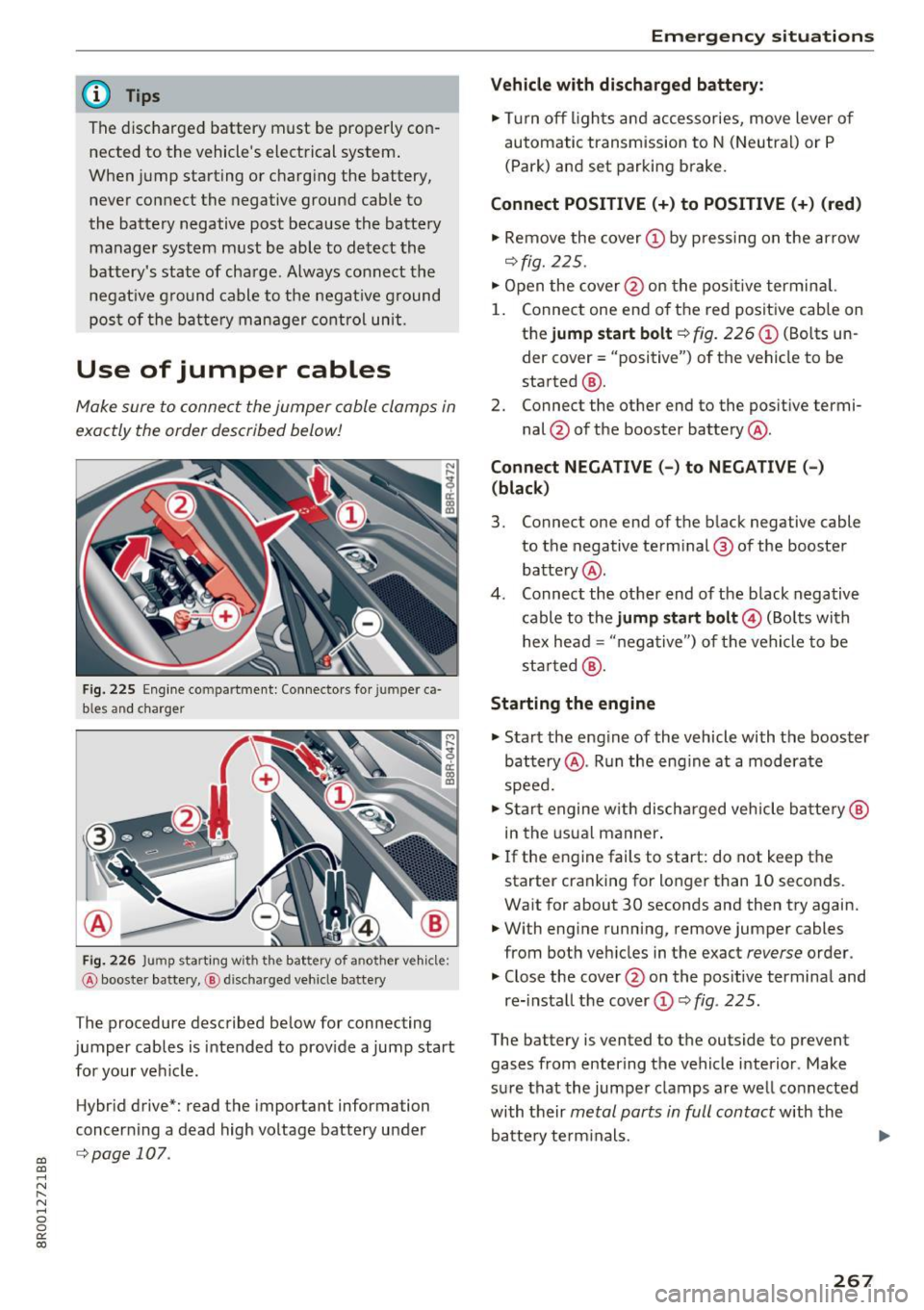
a,
a,
..... N r-N ..... 0 0
0:
co
@ Tips
The discharged battery must be properly con
nected to the vehicle's electrical system .
When jump starting or charg ing the battery,
never connect the negative ground cable to
the battery negative post because the battery
manager system must be able to detect the
battery's state of charge. Always connect the
negative ground cable to the negative ground
post of the battery manager control unit.
Use of jumper cables
Make sure to connect the jumper cable clamps in
exactly the order described below!
Fig. 225 Engine compartment: Connectors fo r jumper ca
bles and charger
Fig. 226 Jump starting with the battery of another vehicle:
@ booster battery, @ discharged vehicle battery
The procedure described below for connecting
jumper cables is intended to provide a jump start
for your vehicle.
Hybrid drive*: read the important information
concerning a dead high voltage battery under
¢page 107.
Emergency situations
Vehicle with discharged battery:
.,. Turn off lights and accessories, move lever of
automatic transmission to N (Neutral) or P
(Park) and set parking brake.
Connect POSITIVE(+) to POSITIVE(+) (red)
"' Remove the cover
CD by pressing on the arrow
¢fig. 225.
.,. Open the cover @on the positive terminal.
1. Connect one end of the red positive cab le on
the
jump start bolt¢ fig. 226 CD (Bolts un
der cover = "positive") of the vehicle to be
started @.
2. Connect the other end to the positive termi-
nal@of the booster battery @.
Connect NEGATIVE (-) to NEGATIVE(-)
(black)
3. Connect one end of the black negative cable
to the negative term i nal @of the booster
battery @.
4. Connect the other end of the b lack negative
cable to the
jump start bolt@ (Bolts with
hex head= "negative") of the vehicle to be
started @.
Starting the engine
.,. Start the engine of the vehicle with the booster
battery @. Run the engine at a moderate
speed .
.,. Start engine w ith discharged vehicle battery@
in the usual manner .
.,. If the engine fails to start: do not keep the
starter cranking for longer than 10 seconds.
Wait for about 30 seconds and then try again .
.,. With engine running, remove jumper cables
from both vehicles in the exact
reverse order.
"' Close the cover @on the positive terminal and
re- install the cover
CD <=> fig . 225.
The battery is vented to the outside to prevent
gases from entering the vehicle interior. Make
sure that the jumper clamps are well connected
with their
metal parts in full contact with the
batte ry term inals. .,.
267
Page 270 of 296
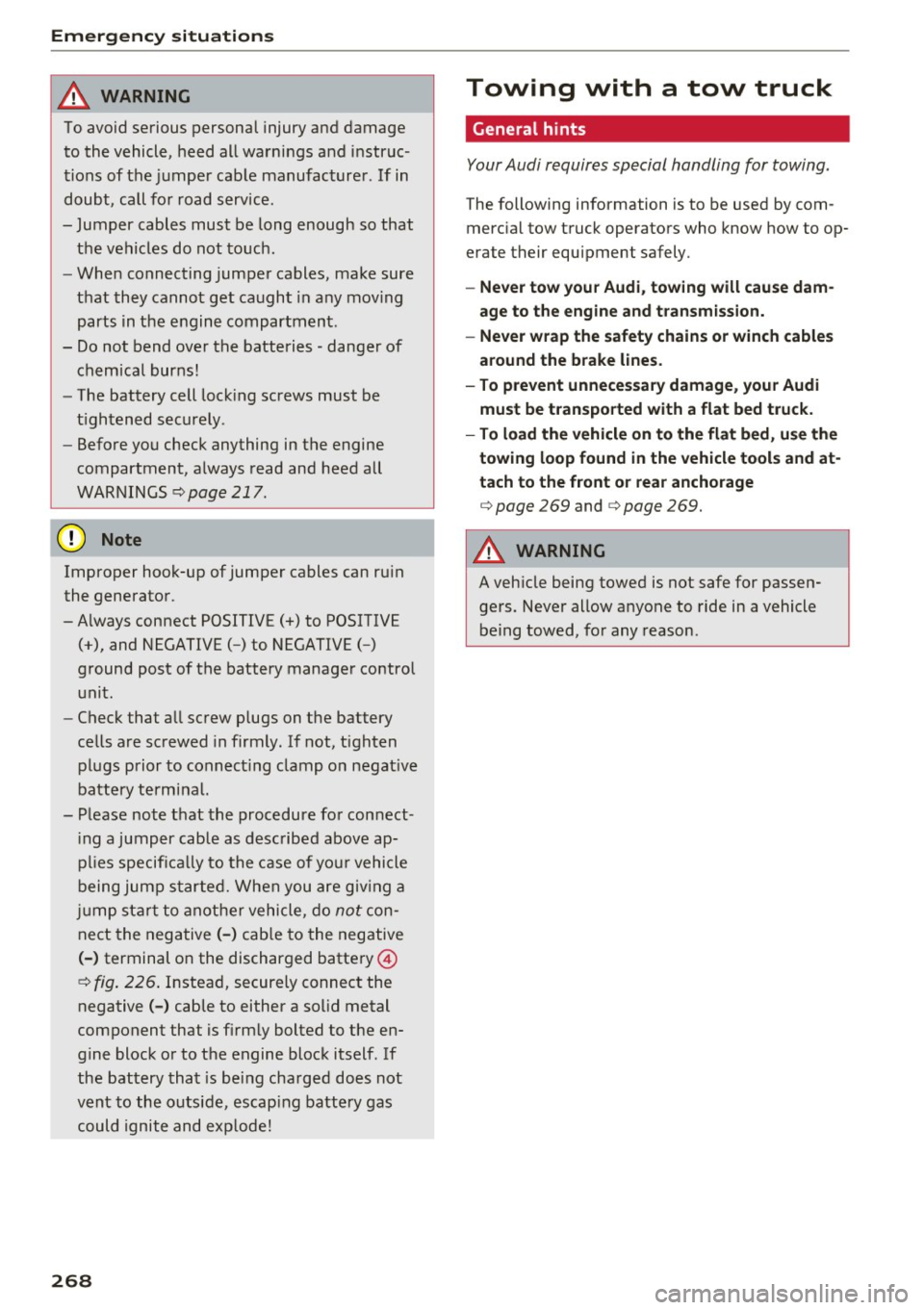
Emerg enc y s it uati ons
& WARNING
To avoid serious personal injury and damage
to the vehicle, heed all warn ings and instruc
tions of the jumper cab le manufacturer . If in
doubt, call for road service .
- Jumper cables must be long enough so that
the vehicles do not touch.
- When connecting jumper cables, make sure
that they cannot get caught in any mov ing
parts in the engine compartment .
- Do not bend over the batteries -danger of
chemical burns!
- The battery cell lock ing screws must be
t ightened securely .
- Before you check anything in the engine
compartment, always read and heed all
WARNINGS ¢page 217.
(D Note
Improper hook-up of jumper cables can ru in
the generator.
- Always connect POSITIVE(+) to POSITIVE
(+), and NEGATIVE( -) to NEGATIVE( -)
ground post of the battery manager control unit.
- Check that all screw p lugs on the battery
cells are screwed in firmly. If not, t ighten
plugs prior to connect ing clamp on negat ive
battery terminal.
- Please note that the procedure for connect
ing a jumper cable as desc ribed above ap
pl ies specifica lly to the case of yo ur vehicle
being jump s tarted. When you are giv ing a
j u mp sta rt to another vehicle , do not con
nect the negative( -) cab le to the negative
( - ) terminal on the discharged battery @
¢ fig. 226 . Instead, securely connect the
negative ( -) cable to either a solid metal
component that is f irm ly bolted to the en
gine block or to the engine block itself . If
the battery that is bei ng charged does not
vent to the outside, escap ing battery gas
could ignite and exp lode!
268
Towing with a tow truck
' General hints
Your Audi requires special handling for towing .
T he following info rmation is to be used by com
merc ial tow truck operators who know how to op
erate their equipment safely.
- Never tow your Audi , tow ing will cause dam
a ge to t he engine and t ran sm ission.
- Ne ver wrap the safety chains or winch cable s
around the brake l ines .
- To prevent un necessary damage , your Audi
must be t ran sported with a flat bed truck.
- To load the vehicle on to the fl at bed , use the
towing loop found in the vehicle tools and at
t ac h to the front o r rear ancho rage
¢ page 269 and ¢page 269.
& WARNING
A vehicle being towed is not safe for passen
gers . Never allow a nyone to ride in a vehicle
be ing towed, for any reason .